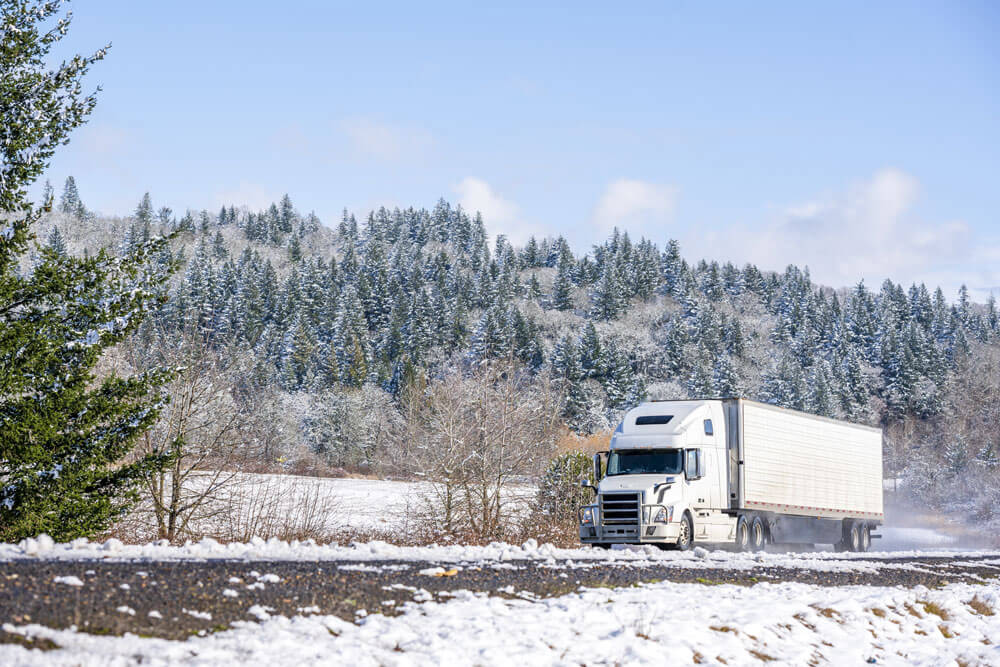Trucking in the snow is more challenging since overall visibility and control over your vehicle are reduced. Driving a semi in the snow requires a certain set of skills, experience, and knowledge. This is because the chances of getting into an accident increase significantly in the winter.
Not to mention, truck drivers are having to operate large and heavy vehicles in these conditions, which makes it even more difficult. Being aware of the risks can help you avoid an accident while trucking in the winter.
In this article, we’re going to discuss some safety tips for truckers hauling goods in the winter.
Safety Guide for Trucking in Snow
Drive Slow
The biggest reason for trucking accidents in the winter is due to speeding. Operating a large vehicle in the snow can be difficult since there’s less traction between the tires and pavement. Therefore, you’ll need more time to come to a stop or make a sudden move. It’s nearly impossible to regain control of your truck once you’re slipping and sliding along the road.
Therefore, truckers should drive below the speed limit to avoid any costly damage due to an accident. Driving at a lower speed also helps you maintain control of your vehicle and increases your reaction time.
Keep a Safe Following Distance
Since your tires have less traction in the snow, you need to keep a safe following distance between your truck and the car in front of you. If you’re driving too close to other vehicles you may not have enough time to bring your truck to a complete stop.
The FMCSA suggests if you’re driving under 40 mph you should leave one second for every 10 feet in length your truck is. Oftentimes you won’t be driving over 40 mph in the snow so this would be a good rule of thumb.
Clean off Your Windshield
It’s not uncommon for ice, snow, and fog to build up on a truck’s windshield, especially when it sits out overnight. Unfortunately, you can’t just pour some water on your windshield and hope it goes away. In fact, pouring hot water on a frozen windshield can cause the glass to crack or shatter.
Therefore, we suggest turning on your defroster and having an ice scraper on hand. While the windshield is defrosting the ice scraper helps get the job done quicker.
Keep a Full Tank of Gas
During the winter, it’s wise to keep your gas tank full or close to it. This is because if you were to get stuck in a snowstorm you’d want enough gas to keep the vehicle running. The last thing you’d want is to be stranded sitting in a cold truck.
Also, if you have low fuel then condensation can form in the tank causing mechanical failures or other costly issues. If this were to happen you could end up in a dangerous situation and become stranded in the cold.
Have Supplies on Hand
During the winter months, you should always keep extra supplies on your truck, such as gloves, jeans, sweatshirts, jackets, hats, food, and water. You never know what could happen out there on the road, such as you could get caught in a snowstorm or run into mechanical issues. Since the weather can be unpredictable in the winter, you want to be prepared for all possible scenarios.
Bottom Line
Trucking in the snow is more dangerous due to poor weather conditions. Lower visibility and control over your truck contribute to the problem and make it harder for truck drivers to stay safe on the road.
Therefore, we suggest you keep a safe distance from yourself and other vehicles, avoid speeding, keep a full tank of gas, have supplies on you, and keep your windshield clean.
Sources
https://www.hg.org/legal-articles/truck-accidents-in-winter-weather-45887
https://novalines.com/tips-for-trucking-in-snow-a-professionals-safety-guide/


